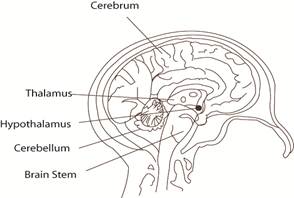
Concept explainers
To write:
To label: the different region of the human brain given in the figure.
Introduction:
The brain is an important part of the body where all the decisions about the body are processed, directed and coordinated.
Explanation of Solution
Structurally, the brain is sub-divided into many important anatomical regions, including the cerebrum, thalamus, cerebellum, hypothalamus, and brain stem.
The whole upper region of the skull is filled with Cerebrum. The cerebrum controls language, voluntary movement, sensation, memory, and decision making.
Thalamus relays information between the cerebrum and the spinal cord. The first part of the brain which receives message signaling such sensation as pain, pressure, and the temperature is thalamus.
The hypothalamus is the control center of sex drive, pleasure, pain, hunger, thrust, blood pressure, and body temperature. It also releases hormones including those regulating the production of egg cells and sperms as well as the menstruation cycle.
The cerebellum controls muscle movement, balance, and coordination. It looks like the smaller form of the cerebrum.
The brain stem consists of the pons, midbrain, and medulla oblongata. Midbrain is the uppermost area of the brain stem which adjusts the sensitivity of our eyes to light and ears to sound. Below the midbrain is the pons which functions as a bridge. The midbrain allows messages to travel from brain to the spinal cord. Medulla oblongata is the brain stem's lowest area. It helps to control the heart rate and conveys information between the spinal cord and other parts of the brain.
The figure shows the various region of the brain-

Fig:
Different part of the human brain
The given diagram shows the various region of the brain.
Want to see more full solutions like this?
Chapter 24 Solutions
Pearson eText Biology: Science for Life -- Instant Access (Pearson+)
- What is this?arrow_forwardMolecular Biology A-C components of the question are corresponding to attached image labeled 1. D component of the question is corresponding to attached image labeled 2. For a eukaryotic mRNA, the sequences is as follows where AUGrepresents the start codon, the yellow is the Kozak sequence and (XXX) just represents any codonfor an amino acid (no stop codons here). G-cap and polyA tail are not shown A. How long is the peptide produced?B. What is the function (a sentence) of the UAA highlighted in blue?C. If the sequence highlighted in blue were changed from UAA to UAG, how would that affecttranslation? D. (1) The sequence highlighted in yellow above is moved to a new position indicated below. Howwould that affect translation? (2) How long would be the protein produced from this new mRNA? Thank youarrow_forwardMolecular Biology Question Explain why the cell doesn’t need 61 tRNAs (one for each codon). Please help. Thank youarrow_forward
- Molecular Biology You discover a disease causing mutation (indicated by the arrow) that alters splicing of its mRNA. This mutation (a base substitution in the splicing sequence) eliminates a 3’ splice site resulting in the inclusion of the second intron (I2) in the final mRNA. We are going to pretend that this intron is short having only 15 nucleotides (most introns are much longer so this is just to make things simple) with the following sequence shown below in bold. The ( ) indicate the reading frames in the exons; the included intron 2 sequences are in bold. A. Would you expected this change to be harmful? ExplainB. If you were to do gene therapy to fix this problem, briefly explain what type of gene therapy youwould use to correct this. Please help. Thank youarrow_forwardMolecular Biology Question Please help. Thank you Explain what is meant by the term “defective virus.” Explain how a defective virus is able to replicate.arrow_forwardMolecular Biology Explain why changing the codon GGG to GGA should not be harmful. Please help . Thank youarrow_forward
- Stage Percent Time in Hours Interphase .60 14.4 Prophase .20 4.8 Metaphase .10 2.4 Anaphase .06 1.44 Telophase .03 .72 Cytukinesis .01 .24 Can you summarize the results in the chart and explain which phases are faster and why the slower ones are slow?arrow_forwardCan you circle a cell in the different stages of mitosis? 1.prophase 2.metaphase 3.anaphase 4.telophase 5.cytokinesisarrow_forwardWhich microbe does not live part of its lifecycle outside humans? A. Toxoplasma gondii B. Cytomegalovirus C. Francisella tularensis D. Plasmodium falciparum explain your answer thoroughly.arrow_forward
- Select all of the following that the ablation (knockout) or ectopoic expression (gain of function) of Hox can contribute to. Another set of wings in the fruit fly, duplication of fingernails, ectopic ears in mice, excess feathers in duck/quail chimeras, and homeosis of segment 2 to jaw in Hox2a mutantsarrow_forwardSelect all of the following that changes in the MC1R gene can lead to: Changes in spots/stripes in lizards, changes in coat coloration in mice, ectopic ear formation in Siberian hamsters, and red hair in humansarrow_forwardPleiotropic genes are genes that (blank) Cause a swapping of organs/structures, are the result of duplicated sets of chromosomes, never produce protein products, and have more than one purpose/functionarrow_forward
 Medical Terminology for Health Professions, Spira...Health & NutritionISBN:9781305634350Author:Ann Ehrlich, Carol L. Schroeder, Laura Ehrlich, Katrina A. SchroederPublisher:Cengage Learning
Medical Terminology for Health Professions, Spira...Health & NutritionISBN:9781305634350Author:Ann Ehrlich, Carol L. Schroeder, Laura Ehrlich, Katrina A. SchroederPublisher:Cengage Learning





